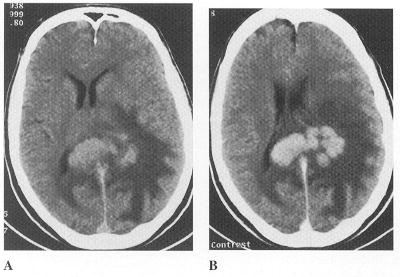 |
| Primary cerebral lymphoma; CT before (A) and after intravenous contrast medium
(B). An irregular mass which is hyperdense to grey matter, expands the splenium of the
corpus callosum and extends into the left hemisphere. It is surrounded by extensive white
matter oedema and enhances avidly with contrast. |
|
Brain (CNS) Lymphoma
The treatment of this disease is controversial
as noted by the NCI: "Because of the diffuse nature of CNS lymphomas, aggressive
surgical decompression with partial or gross total removal of the tumor is of no benefit
to the patient. Median survival with surgery alone is in the range of only 1-5 months.
Until recently, radiation therapy has been the standard treatment, with doses of up to 45
Gy using standard fractionation. When the Radiation Therapy Oncology Group used 40 Gy
whole-brain irradiation and a 20 Gy boost to the tumor, the results were no better than
had been previously reported, with median survival of 1 year and 28% surviving 2 years.
Disease recurs in the brain in 92% of patients despite the high doses of radiation. The
addition of spinal axis radiation does not affect survival because it does not prevent
cerebral relapse.
Two multicenter
prospective trials used pre-irradiation cyclophosphamide, doxorubicin, vincristine, and
dexamethasone followed by whole-brain irradiation. Median survival times were no better
than for radiation therapy alone. The failure of these and other combined modality
trials has been attributed to poor penetration of standard drugs through the blood-
brain barrier and to increased neurotoxicity.A retrospective review of 226 patients
suggested improved results using high-dose methotrexate or cytarabine with radiation
therapy over other combination regimens. |

